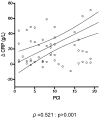Inflammatory Response and Toxicity After Pressurized IntraPeritoneal Aerosol Chemotherapy
- PMID: 29290765
- PMCID: PMC5743707
- DOI: 10.7150/jca.21460
Inflammatory Response and Toxicity After Pressurized IntraPeritoneal Aerosol Chemotherapy
Abstract
Background: Pressurized Intraperitoneal Aerosol Chemotherapy (PIPAC) is a novel mode of intraperitoneal (IP) drug delivery claiming high IP tissue concentrations with low systemic uptake. The aim was to study inflammatory response and systemic toxicity after PIPAC. Methods: Retrospective monocentric analysis of a consecutive cohort of PIPAC patients between January 2015 and April 2016. Detailed hematological and biochemical analysis was performed the day before surgery and once daily until discharge. Comparative statistics were performed using Mann-Whitney U test and Wilcoxon signed ranked test. Results: Fourty-two consecutive patients underwent a total of 91 PIPAC procedures. Twenty patients received oxaliplatin and 22 cisplatin+doxorubicin (37 vs. 54 procedures). Creatinine, AST and ALT were not significantly altered after PIPAC (p=0.095, p= p=0.153 and p=0.351) and not different between oxaliplatin and cisplatin+doxorubicin regimens (p=0.371, p=0.251 and p=0.288). C-reactive protein (CRP) and procalcitonin (PCT) increased on post-operative day (POD) 2: ∆max 29±5 mg/L (p<0.001) and ∆max 0.05±0.01 μg/L (p=0.005), respectively. Leucocytes increased at POD 1: ∆max 2.2±0.3 G/L (p<0.001). Albumin decreased at POD 2: ∆max -6.0±0.5 g/L (p<0.001). CRP increase correlated positively with Peritoneal Cancer Index (tumor load) (ρ =0.521, p<0.001). Conclusion: PIPAC was followed by a modest and transitory inflammatory response that was commensurate to the disease extent. No hematological, renal or hepatic toxicity was observed even after repetitive administration.
Keywords: Intraperitoneal Chemotherapy; PIPAC; Peritoneal Carcinomatosis; Toxicity.
Conflict of interest statement
Competing Interests: The authors have declared that no competing interest exists.
Figures





References
-
- Solass W, Kerb R, Murdter T, Giger-Pabst U, Strumberg D, Tempfer C, Zieren J, Schwab M, Reymond MA. Intraperitoneal chemotherapy of peritoneal carcinomatosis using pressurized aerosol as an alternative to liquid solution: first evidence for efficacy. Annals of surgical oncology. 2014;21(2):553–559. - PMC - PubMed
-
- Solass W, Hetzel A, Nadiradze G, Sagynaliev E, Reymond MA. Description of a novel approach for intraperitoneal drug delivery and the related device. Surgical endoscopy. 2012;26(7):1849–1855. - PubMed
-
- Facy O, Al Samman S, Magnin G, Ghiringhelli F, Ladoire S, Chauffert B, Rat P, Ortega-Deballon P. High pressure enhances the effect of hyperthermia in intraperitoneal chemotherapy with oxaliplatin: an experimental study. Annals of surgery. 2012;256(6):1084–1088. - PubMed
-
- Esquis P, Consolo D, Magnin G, Pointaire P, Moretto P, Ynsa MD, Beltramo JL, Drogoul C, Simonet M, Benoit L. et al. High intra-abdominal pressure enhances the penetration and antitumor effect of intraperitoneal cisplatin on experimental peritoneal carcinomatosis. Annals of surgery. 2006;244(1):106–112. - PMC - PubMed
-
- Glehen O, Gilly FN, Boutitie F, Bereder JM, Quenet F, Sideris L, Mansvelt B, Lorimier G, Msika S, Elias D. et al. Toward curative treatment of peritoneal carcinomatosis from nonovarian origin by cytoreductive surgery combined with perioperative intraperitoneal chemotherapy: a multi-institutional study of 1,290 patients. Cancer. 2010;116(24):5608–5618. - PubMed
LinkOut - more resources
Full Text Sources
Other Literature Sources
Research Materials
Miscellaneous

